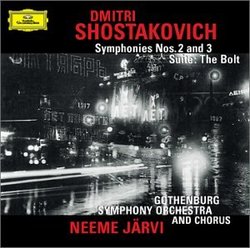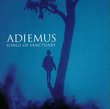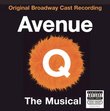| All Artists: Shostakovich, Gso, Jarvi Title: Dmitri Shostakovich: Symphony No. 2, Op. 14 "To October" / Symphony No. 3, Op. 20 "The First of May" / Suite from "The Bolt", Op. 27a - Gothenburg Symphony Orchestra / Neeme Järvi Members Wishing: 0 Total Copies: 0 Label: Deutsche Grammophon Release Date: 3/13/2001 Genre: Classical Style: Symphonies Number of Discs: 1 SwapaCD Credits: 1 UPC: 028946952528 |
Search - Shostakovich, Gso, Jarvi :: Dmitri Shostakovich: Symphony No. 2, Op. 14 "To October" / Symphony No. 3, Op. 20 "The First of May" / Suite from "The Bolt", Op. 27a - Gothenburg Symphony Orchestra / Neeme Järvi
 | Shostakovich, Gso, Jarvi Dmitri Shostakovich: Symphony No. 2, Op. 14 "To October" / Symphony No. 3, Op. 20 "The First of May" / Suite from "The Bolt", Op. 27a - Gothenburg Symphony Orchestra / Neeme Järvi Genre: Classical
Shostakovich's Second and Third Symphonies are crudely propagandistic affairs, dealing, respectively, with the October Revolution and May Day. They're among the least played of his works. But for all their faults, they sho... more » |
Larger Image |
CD DetailsSynopsis
Amazon.com Shostakovich's Second and Third Symphonies are crudely propagandistic affairs, dealing, respectively, with the October Revolution and May Day. They're among the least played of his works. But for all their faults, they show flashes of the young composer's genius and retain interest until they sink in the mire of the closing choruses, which loudly declaim their drivel. Coming after the brilliant First Symphony, these two are a big letdown, but admirers of the composer should hear them, since they have smudged fingerprints of stylistic traits later developed more fully and satisfactorily. The Bolt is a suite derived from a satiric 1931 ballet. Its eight movements include some deliciously funny episodes and spirited high jinks. The entire program is played with committed advocacy by Neeme Järvi and his excellent Swedish orchestra. Shostakovich completists will want this; neophytes should start with later masterpieces, like the Fourth, Fifth, Eighth, and Tenth Symphonies, reflective of the composer at his best. --Dan Davis Similar CDs
Similarly Requested CDs |
CD ReviewsSpectacular Shostakovisch 02/12/2002 (5 out of 5 stars) "This Cd is a spectacular one, because Järvi put Shostakovich hymns to Lenininsm on this record, his no.2 and no.3 + ballet suite from "The Bolt". Shostakovich 2 & 3 symphonies and "The Bolt" is GREAT pieces of early modernism and IF he did go for Lenin hymns in those it was probably because he wrote this when he had hopes for communism at that time (something most of his other symphonies def. NOT show any sign of). This was before Stalins terror had reached its "peak" (sorry for this eventually bad choosen word.. Im in no way like to offend people by this word, but cant find a better synonym in english), five year plans and so on. He never wanted this symphonies and "The Bolt" to be played after Stalins five year plans, Stalins terror and his dissapointment about russian politics was hunting him for the rest of his life.About the music: all this recorded here is early modernistic masterpieces, and Järvi handle this with great insight as a former USSR native (even if his real native country is Estonia... a country incorporated/occupied by USSR under Järvis grown up period).Järvis Gothenburg orchestra and choirs perform this pieces ecxellent, bombastic as it was meant to be (and "The Bolt" trying to be "fun").The sound is fantastic and its both fun listen to and in the same way bizarre symphonies and ballet suite presented on this disc, thinking of subjects as "To october" (in symph no. 2) and "the first of may" (in symph no. 3) with choruses going on like "Comrade Lenin gives us everything" and stuff like that.Shostakovisch was intellectual and emotional tortured by the USSR regime soon after this two symphonies and put his next symphony, in my opinion his greatest no. 4 in his desk and that probably saved his life because of its modernism and it had probably NOT be appriciated by USSR cencors and Stalin.THIS disc is a must have for all of You intrested in Shostakovisch, his life, his music (you could followed his anger of USSR "development" and his fear for Stalin after this if you listen to his other symphonies followed), music history in general and early "techno" modernism. This is, togheter with his first, fifth and fourth, Prokofievs no 3 and 4, 5, Stravinskys early work and Bartoks fantastic music from this time.Järvi and Gothenburg (and DG) has made a very good record of this Shostakovich and russian music period (as a swede, I am NOT biased :-).Highly recommended" Early Shostakovich Brett A. Kniess | Madison, WI | 04/05/2006 (5 out of 5 stars) "The three works on this disk: Symphonies 2 & 3 and the Ballet Suite from The Bolt, show the effect of Soviet propaganda on Dmitri Shostakovich, especially in his early years. Symphony 2, a celebration of the October Revolution, was commissioned by the propaganda department of the State Publishing House; Symphony No. 3, an evocation of the worker's holiday on May 1st; and the ballet The Bolt, about a factory saboteur, is unusually varied and optimistic. While Shostakovich disowned these pieces later in life, they provide a glimpse into his early Soviet sound, and a historical view of his musical progress. The 18-minute Symphony No. 2 "October" and the 27-minute Symphony No. 3 "First of May" have some common elements; both have only one movement and both end with a victorious Russian chorus. That being said, it can even be surmised that both works follow the same sort of progression: workers, surrounded by chaos and hunger, are released from their state of being by Lenin, and a moving Russian chorus heralds those achievements. Indeed, Symphony No. 2, begins in very low strings (chaos-like) and adds higher-voiced strings one by one, until a major arrival and climax is happened upon. This symphony also has some interesting solos, virtuosic chamber settings, some battle-like music, not to mention an eruption into a dance. Symphony 2 ends in a celebratory manner, heralded by a factory whistle, a sung chorale, pealing bells, dramatic pedal points; all in all a satisfying and glorious conclusion. Symphony No. 3, while more tuneful than No.2, still has dissonance leading into the satisfying conclusion. The work begins with a pastoral mood with a walking bass line under the melodies, a march and scherzo follow, with some indication of folk-like, musical settings. While there is a definite dance in the middle of the work, the resolution only occurs when the chorus enters at the end, a grand march ensues complete with fanfares, and the tension built from beginning to end, minor to major, chaos to release, is very satisfying. More fleshed out than No. 2, there are many more dramatic moments, and more variety of musical styles. The 30-minute Bolt Suite is in eight parts: Overture, Bureaucrat's Dance (Polka), Drayman's Dance (Variation), Kozelkov's Dance and his Friends (Tango), Intermezzo (Destroyer), Dance of Colonial Bondswomen and Slave Girl's Dance, Conciliator (Yes-Man), and General Dance and Apotheosis (Finale). Each are inventive, tuneful, and varied miniatures: loud brass calls over a military snare and orchestra hits open the work. Two tongue-in-cheek dances, polka and variation, (the polka featuring piccolo, clarinet, bassoon, trombone, and tuba) vie between playfulness and seriousness. Kozelkov's Dance is slightly sensual with a definite Russian sounding melody, and even a jazzy, syncopated feel, a struggle between popular and Russian sounds. The Intermezzo is a gentile dance, whereas the slave girl's dance is an exotic presto. The humorous Conciliator has a slinky melody, including xylophone, moves to an ominous march. There is a riotous ending dance with a grand conclusion. Neemi Jarvi and the Gothenburg Symphony Orchestra and Chorus give some dynamic and boisterous performances. The orchestra is committed to the music and really dig in and give some gritty Russian sounds, not to mention their great sense of ensemble. Jarvi chooses the extroverted route, and the youthfulness of Shostakovich's early compositions come through; spontaneous and virile interpretations. The chorus is OK; they fare better on Symphony No. 3 than on No. 2; some tuning and support issues, especially in the high range sopranos; in No. 3, however, they perform well. The DG sonics have a good ambient presentation, making the ensemble sound naturally full and vibrant; and 75 minutes long, the CD is full of music. While this probably shouldn't be the starting point for those wanting to experience Shostakovich for the first time, these are hot-blooded performances of his early works, a neat glimpse into the young fiery composer. An interesting buy and certainly recommended." My favourite versions for these symphonies. Francisco Yanez Calvino | Santiago de Compostela, GALIZA, Spain. | 01/30/2006 (5 out of 5 stars) "I'm not a great fan of Neeme Jarvi, even he had recorded some very good performances for DG, but I have to say this is a very good CD, very well played and fine recorded.
The most important thing we have here are the two symphonies, number 2 and 3, from the modernist period of Shostakovich, very influenced by works like Berg's Wozzeck, which the own DSCH listened in Leningrad in his youth years. Of course these works are not so great like the symphonies he wrote some years later (specially from the 5th) but are very important to listen because they show how good composer DSCH was when he was in his 20's. The kind of composition DSCH wrote here is not developed in many works after, even you can recognize his print in the very first movement of the Second, like it happens in his First Symphony. The world that emerge from the Symphony Nº2 is the world of the Russian workers in a tone-poem which is in fact a propagandistic work for the soviet regime, anyway I have no doubts about the very bad situation of the Russian proletarian, but some times in this kind of works it sounds like a cliché. The final texts in both symphonies are clear, easy to understand, exalting Lenin's figure in order to become art for the people, art with a political purpose. I think art have this kind of roles too, apart from many others and it's very interesting to listen it from our days, like watching Battleship Potenkim, Einsestein's masterwork from that same years. The performances are very clear, very well done from the technical point of view with an orchestra that know fairly well DSCH language, like the own Neeme Jarvi, who signs his best Shostakovich's recording in this CD. Sound is great, really wonderful and I would say this is the best CD to know these works, even we have a magnificent recording for The Bolt, with Rozhdestvensky in Chandos. " |

 Track Listings (18) - Disc #1
Track Listings (18) - Disc #1





